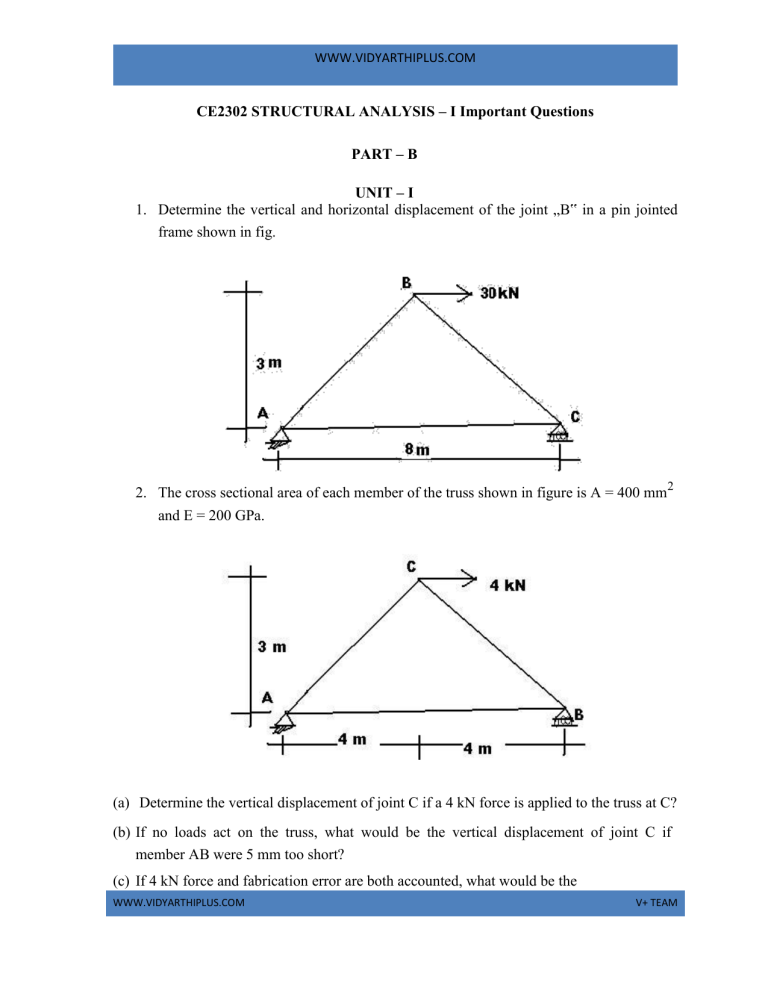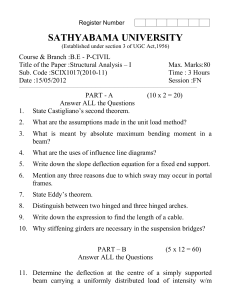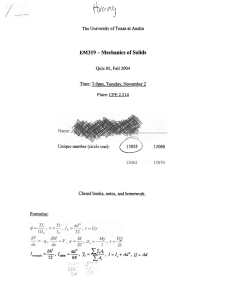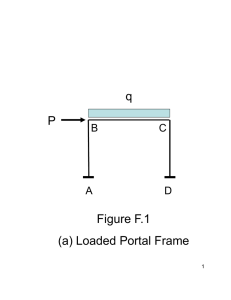
WWW.VIDYARTHIPLUS.COM CE2302 STRUCTURAL ANALYSIS – I Important Questions PART – B UNIT – I 1. Determine the vertical and horizontal displacement of the joint „B‟ in a pin jointed frame shown in fig. 2. The cross sectional area of each member of the truss shown in figure is A = 400 mm2 and E = 200 GPa. (a) Determine the vertical displacement of joint C if a 4 kN force is applied to the truss at C? (b) If no loads act on the truss, what would be the vertical displacement of joint C if member AB were 5 mm too short? (c) If 4 kN force and fabrication error are both accounted, what would be the WWW.VIDYARTHIPLUS.COM V+ TEAM WWW.VIDYARTHIPLUS.COM vertical displacement of joint C? 3. Determine the vertical displacement of joint C of the steel truss as shown in fig. Due to radiant heating from the wall, members are subjected to a temperature change; member AD is increase +60°C, members DC is increases +40°C and member AC is decrease - 20°C. Also member DC is fabricated 2mm too short and member AC 3mm too long. Take α = 12(10-6), the cross sectional area of each member is A = 400 mm2 and E = 200 GPa? 4. A beam AB is simply supported over a span 6m in length. A concentrated load of 45kN is acting at a section 2m from support. Calculate the deflection under the load point. Take E = 200 x 106 kN/m2. And I = 13 x 10-6 m4 WWW.VIDYARTHIPLUS.COM V+ TEAM WWW.VIDYARTHIPLUS.COM 5. A beam AB is simply supported over a span 5m in length. A concentrated load of 30kN is acting at a section 1.25m from support. Calculate the deflection under the load point. Take E = 200 x 106 kN/m2. And I = 13 x 10-6 m4 UNIT-II 1. A beam ABC is supported at A, B and C as shown in Fig. 7. It has the hinge at D. Draw the influence lines for 1. reactions at A, B and C 2. shear to the right of B 3. bending moment at E D E B A 4m C 2m 3m 8m 2. Determine the influence line ordinates at any section X on BC of the continuous beam ABC shown in Fig. 8, for reaction at A. X B A 5m WWW.VIDYARTHIPLUS.COM x C 5m V+ TEAM WWW.VIDYARTHIPLUS.COM 3. Sketch qualitatively the influence line for shear at D for the beam in Fig. 2. (Your sketch shall clearly distinguish between straight lines and curved lines) B A D C 0.8 l l 1.6 l 4. A single rolling load of 100 kN moves on a girder of span 20m. (a) Construct the influence lines for (i) Shear force and (ii) Bending moment for a section 5m from the left support. (b) Construct the influence lines for points at which the maximum shears and maximum bending moment develop. Determine these maximum values. 5. Derive the influence diagram for reactions and bending moment at any section of a simply supported beam. Using the ILD, determine the support reactions and find bending moment at 2m, 4m and 6m for a simply supported beam of span 8m subjected to three point loads of 10kN, 15kN and 5kN placed at 1m, 4.5m and 6.5m respectively. 6. Two concentrated rolling loads of 12 kN and 6 kN placed 4.5 m apart, travel along a freely supported girder of 16m span. Draw the diagrams for maximum positive shear force, maximum negative shear force and maximum bending moment. WWW.VIDYARTHIPLUS.COM V+ TEAM WWW.VIDYARTHIPLUS.COM UNIT-III 1. A three hinged parabolic arch of span 100m and rise 20m carries a uniformly distributed load of 2KN/m length on the right half as shown in the figure. Determine the maximum bending moment in the arch. 2. A two hinged parabolic arch of span 20m and rise 4m carries a uniformly distributed load of 5t/m on the left half of span as shown in figure. The moment of inertia I of the arch section at any section at any point is given by I = I0 sec where = inclination of the tangent at the point with the horizontal and I0 is the moment of inertia at the crown. Find (a) (b) (c) The reactions at the supports The position and The value of the maximum bending moment in the arch. 3. A symmetrical parabolic arch spans 40m and central rise 10m is hinged to the abutments and the crown. It carries a linearly varying load of 300 N/M at each of the abutments to zero at the crown. Calculate the horizontal and vertical reactions at the abutments and the position and magnitude of maximum bending moment. 4. A three hinged stiffening girder of a suspension bridge of span 100m is subjected to two points loads of 200 kN and 300 kN at a distance of 25 m and 50 m from the left end. Find the shear force and bending moment for the girder. WWW.VIDYARTHIPLUS.COM V+ TEAM WWW.VIDYARTHIPLUS.COM 5. A three hinged parabolic arch of 20m span and 4 m central rise carries a point load of 4kN at 4m horizontally from the left hand hinge. Calculate the normal thrust and shear force at the section under the load. Also calculate the maximum BM Positive and negative. 6. A parabolic arch, hinged at the ends has a span of 30m and rise 5m. A concentrated load of 12kN acts at 10m from the left hinge. The second moment of area varies as the secant of the slope of the rib axis. Calculate the horizontal thrust and the reactions at the hinges. Also calculate the maximum bending moment anywhere on the arch. 7. The figure shows a three hinged arch with hinges at a A, B and C. The distributed load of 2000N/m acts on CE and a concentrated load of 4000N at D. Calculate the horizontal thrust and plot BMD. WWW.VIDYARTHIPLUS.COM V+ TEAM WWW.VIDYARTHIPLUS.COM UNIT-IV 1. Analyse the continuous beam given in figure by slope deflection method and draw the B.M.D 2. Analyze the frame given in figure by slope deflection method and draw the B.M.D 3.Using slope deflection method, determine slope at B and C for the beam shown in figure below. EI is constant. Draw free body diagram of BC. 4. A continuous beam ABCD consist of three span and loaded as shown in fig.1 end A and D are fixed using slope deflection method Determine the bending moments at the supports and plot the bending moment diagram. WWW.VIDYARTHIPLUS.COM V+ TEAM WWW.VIDYARTHIPLUS.COM 5. A portal frame ABCD, fixed at ends A and D carriers a point load 2.5Kn as shown in figure – 2. Analyze the portal by slope deflection method and draw the BMD. 6. Using slope deflection method analyzes the portal frame loaded as shown in Fig (1). EI is constant. 7. Using slope deflection method analyzes a continuous beam ABC loaded as shown in Fig (2). The ends A and C are hinged supports and B is a continuous support. The beam has constant flexural rigidity for both the span AB and BC. WWW.VIDYARTHIPLUS.COM V+ TEAM WWW.VIDYARTHIPLUS.COM UNIT –V 1. Draw the bending moment diagram and shear force diagram for the continuous beam shown in figure below using moment distribution method. EI is constant. 2. Analysis the frame shown in figure below for a rotational yield of 0.002 radians anticlockwise and vertical yield of 5mm downwards at A. assume EI=30000 kNm 2. IAB = ICD = I; IBC = 1.51. Draw bending moment diagram. Use moment Distribution Method. 3. Draw the bending moment diagram and shear force diagram for the continuous beam shown in figure below using moment distribution method. EI is constant. 4. A beam ABCD, 16m long is continuous over three spans AB=6m, BC = 5m & CD = 5m the supports being at the same level. There is a udl of 15kN/m over BC. On AB, is a point load of 80kN at 2m from A and CD there is a point load of 50 kN at 3m from D, calculate the moments by using moment distribution method. Assume WWW.VIDYARTHIPLUS.COM V+ TEAM WWW.VIDYARTHIPLUS.COM EI const. 5. Analyze a continuous beam shown in Fig (3) by Moment distribution method. Draw BMD. 6. A continuous beam ABCD of uniform cross section is loaded as shown in Fig(5) Find (a) Bending moments at the supports B and C (b) Reactions at the supports. Draw SFD and BMD also WWW.VIDYARTHIPLUS.COM V+ TEAM





